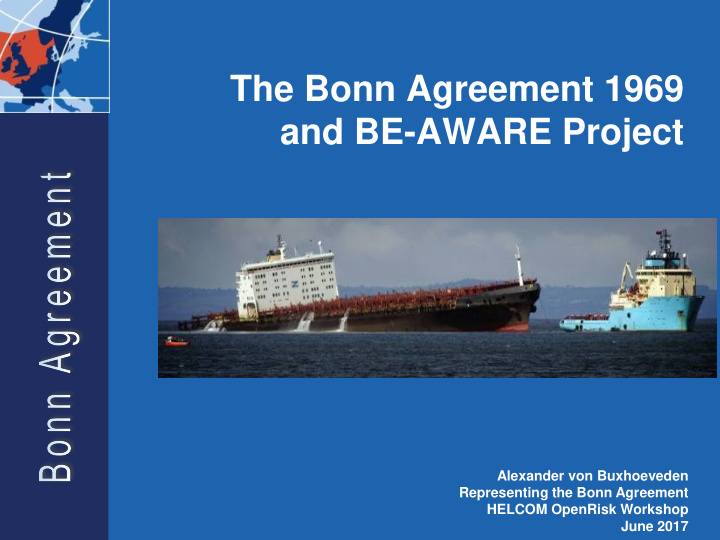



The Bonn Agreement 1969 and BE-AWARE Project Alexander von Buxhoeveden Representing the Bonn Agreement HELCOM OpenRisk Workshop June 2017
History of the Bonn-Agreement • The Bonn Agreement is the oldest regional agreement established by governments for responding to pollution incidents. • The first "Agreement for Cooperation in Dealing with Pollution of the North Sea by Oil" was signed in 1969. • The original 1969 agreement was replaced in 1983 by a new Bonn Agreement covering "other harmful substances”. • In 1989 the text of the Bonn Agreement was amended to include within its remit aerial surveillance for the detection of operational and illegal spills. • In 2001, Bonn Agreement Contracting Parties adopted a Decision providing for the accession of Ireland to the Bonn Agreement. • In 2010, the Bonn Agreement Ministerial Meeting was held in Dublin on 24 November .
Obligations for Contracting Parties • Surveillance for threats of marine pollution • Alerting Contracting Parties to pollution threats • Development of common operational approaches (e.g. Counter Pollution Manual) • Response operations • Carrying out joint exercises • Sharing research and development
48 years of cooperation
Bonn Agreement Strengths • Practical products • Joint operations • Personal contacts • Professional continuity • Wealth of technical expertise • Sharing and cooperation
Exercises, Aerial Surveillance and Tour d`Horizon Aerial surveillance and Tour d’Horizon
Increased extreme weather events Changes in the shipping sector
Future challenges • Implementation of the Bonn Agreement Action Plan. • BE-AWARE Implementation Plan • Responding to spills in wind farm areas • Pollution threats from hazardous and noxious substances • Ensure the organisation is fit for purpose in a changing operational environment
Bonn Agreement: Area-wide Assessment of Risk Evaluations Co-Financed by the EU Civil Protection Mechanism
BE-AWARE objectives 2011 • identify areas at increased risk of pollution, • the potential for spills in those areas and the criteria for undertaking an analysis of the socioeconomic and environmental vulnerability. BE-AWARE objectives 2013 • to identify the most effective future risk reduction and response measures, • building directly upon the outcomes of the BE- AWARE project.
BE-AWARE II achievements: • To identify alternative future (2020) scenarios for risk reduction measures and response capacities; • To model the fate and weathering of oil for the potential spills identified in BE-AWARE for each of the scenarios; • To identify the socioeconomic and environmental vulnerability of the coastline and offshore areas using the tools developed in BE-AWARE;
BE-AWARE II achievements: • To identify the impacts of spilt oil in the natural environment as well on socio-economic features, taking into consideration the relevant vulnerabilities for each of the selected scenarios; • To develop risk management conclusions for Bonn Agreement sub-regions based on the most efficient and cost effective scenarios identified. • Promoting common understanding of risk assessment practices and cross border risk management
BE-AWARE Implementation Plan • Adopted by BONN 16 • Priorities for each sub region • To be reviewed annually
www.bonnagreement.org beaware.bonnagreement.org
Recommend
More recommend